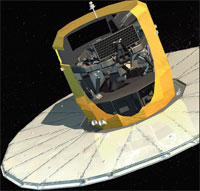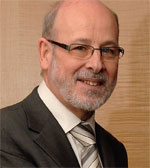According to a recent study of children’s learning habits, space and dinosaurs remain the two scientific subjects that are most certain to fire the imaginations of youngsters.
Bob Graham - head of engineering at Europe’s largest space company, EADS Astrium - couldn’t agree more. But this, he said, is where the similarity ends. ’I’m not suggesting that space is in any way a dinosaur,’ he added. ’It might have stopped grabbing the headlines in the way that it used to, but it’s really motivating to know that it still provides such a stimulus.’ With more than 30 years of experience in the industry, Graham admits that the sector may not appear to be as exciting as it was in the golden years of manned-space exploration. ’It’s a shame,’ he said, ’because in reality, a lot of fascinating things are happening behind the scenes.’

While high-profile human space expeditions have tended to dominate public interest in space, the industry’s impact on our lives is more profound than ever, said Graham. Satellite technology is the classic example. From policing greenhouse emissions to monitoring activity in war zones, the introduction of data streams from space has opened up huge global opportunities.
Graham cites the example of the Highly Adaptable Satellite (HYLAS), a low-cost system designed and built by Astrium for British communications group, Avanti. The satellite, due to be launched in September, is aimed at helping to solve the problem of unequal access to broadband services and will cover rural areas of western and central Europe that are unlikely to receive terrestrial broadband within the next 10 years.
20-year strategy claims the UK space industry may grow to £40bn a year bobgraham and create 100,000 jobs
’From my perspective, HYLAS is a key step forward in terms of helping the government satisfy its digital needs,’ said Graham. ’If you take that to the next stage then you can start looking towards Africa, where they clearly have very minimal ground-based infrastructure and this satellite provides a fantastic opportunity for the future.’
The communications payload for HYLAS was manufactured at Astrium’s UK sites in Stevenage and Portsmouth, as are the payloads for the quarter of the world’s telecommunications satellites that are also developed by Astrium. Graham believes the expected global increase in satellites, combined with British manufacturing expertise in the area, could mean that space will become a key contributor to the UK economy.
Recent industry figures support this claim. In 2007, the UK space industry generated revenues of £5.6bn, of which £2.8bn contributed directly to the country’s GPD. It held six per cent of the industry’s global share and supported 68,000 jobs. A 20-year strategy, outlined by the UK Space Innovation and Growth Team, claims that the industry could grow to £40bn a year and has the potential to create 100,000 new jobs by 2030.
’It’s entirely possible for us to keep that growth in the UK,’ said Graham. ’What we’re really great at as a country is advanced manufacturing. Not only in space, but in other areas too things such as nanotechnology are strong in the UK. We’re following companies that are developing it on a large scale so that we can apply it to particular missions. This has opened up opportunities in using new technology developed in other industries, rather than necessarily just spinning out some of our own.’
“What we’re really great at as a country is advanced manufacturing. Not only in space, but in other areas such as nanotechnology”
One area in which Graham sees potential is the use of additive technology in satellite antenna systems. Currently, these antennae are produced by either welding components or using electrolysis plating techniques. These pieces are required to have both a high dimensional accuracy and a good surface finish. ’Quite often we would silver plate the inside of these components as the radio frequency performance is impacted by their texture,’ explained Graham. ’We see additive technology as providing a good means of producing these very complex geometry shapes with the minimum of jointing, because every joint is a potential source of signal loss.’

However, Graham is keenly aware that more needs to be done in promoting expertise in areas such as advanced manufacturing if the UK is to keep its competitive edge. The establishment of a UK Space Agency to co-ordinate government space strategy by the outgoing science minister, Lord Drayson, has been seen as a step in the right direction. But the possibility of policies being halted under a coalition government still remains a concern. ’This is always a risk with a new government,’ said Graham. ’But the Conservatives are aware of where the space industry is and what we need to do is keep the momentum going.’
Over the last decade, both industry and government have been criticised for failing to use the opportunities provided by space technology. Graham claims the back-to-back reviews on space in the UK have not ignited the action from policy makers that they had intended, but believes that this will begin to change in the coming years.
’I believe the future is heading towards much more integrated data systems. If you look at the mobile phone technology you have now, it is absolutely incredible. I can see space satellites developing that further, particularly with the instant data, the instant update of information provided through spacecraft. It’s about communication access both from speech, imaging, positioning, banking on the move all of these sorts of things. I think there’s a fantastic future out there.’
Q&A
How did you get into the space industry?
I started my working life in the missile side of the industry. And then, nearly 30 years ago, I was given the opportunity to come and be involved in space by designing a support structure to go into the Space Shuttle. And then just stayed there because the breadth of the work, the opportunity to design very light-weight structures, the demanding timescales, all of that was just a great engineering stimulation. Coupled with the fact that the missions that we do, both from telecommunications spacecraft, direct to home TV broadband systems, through to the science missions, the ability to introduce and develop new technology and to boldly go where no one else goes.
What do you believe is the biggest barrier to innovation in space technology?
Space is a conservative industry from a customer’s perspective. If you consider that we produce a telecommunications spacecraft that has to survive the rigours of launch, such as the vibration levels and the very high acceleration levels from the launcher. Because you can’t bring it back into the garage or send the AA out to fix it we need to have extremely high reliability, high quality, verification of the performance on the ground prior to putting it into space, which takes time.
What spacecraft components could benefit most from the use of advanced manufacturing techniques?
The fuel tank is a good example. Due to zero gravity in space the fuel moves inside the tank. There is an outlet in the bottom of the tank that must always have to keep a quantity of fuel covering the pipe, so we have a sponge-like device that has a capillary action that is able to change the quantity of fuel in presence with the outlet pipe. These devices that we’ve put in the tanks are essentially a sort of sponge structure and we have seen that additive manufacturing can provide significant advantages in improving the performance and the manufacture and effectively the cost of some of the devices that we currently use. We are therefore doing investigations in that at the moment.
Do you think we are seeing a trend towards smaller satellites?
This is a question that I think has vexed the industry for quite a few years. There are parallels if you go back into the computing industry where everyone thought large mainframes were the way ahead, then it moved into desktops. I think it probably comes down to the market conditions. There are nations and companies that can’t afford a full satellite system, but have a desire for a mission that could be satisfied by a smaller satellite.
Bob Graham - biography

Education
1973 Received a first-class degree in Aeronautical Engineering at Hatfield Polytechnic
Career
- 1968 Undergraduate apprentice at Hawker Siddeley Dynamics
- 1973 Design engineer at Hawker Siddeley Dynamics/BAE Dynamics
- 1976 Stress engineer at Hunting Engineering
- 1978 Consultant stress engineer at BAE Dynamics for the Sea Eagle missile system
- 1982 Senior engineer for BAE Dynamics Space Division
- 1984 Head of structures for BAE Dynamics Space Division
- 1989 Assistant chief engineer at BAE Space Systems
- 1994 Structural products manager at Matra Marconi Space
- 1998 Directorate engineering manager at Matra Marconi Space
- 2000 Head of engineering at Astrium Earth Observation and Science (UK)




Nanogenerator consumes CO2 to generate electricity
Whoopee, they've solved how to keep a light on but not a lot else.